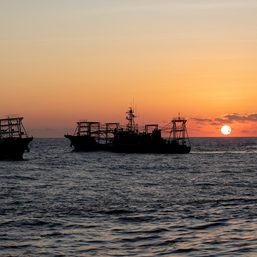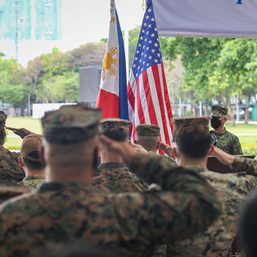SUMMARY
This is AI generated summarization, which may have errors. For context, always refer to the full article.
Even the coronavirus didn’t slow down China’s adventurism in the South China Sea. In the middle of April, a month after the World Health Organization declared a pandemic, Beijing sent Chinese survey ship Haiyang Dizhi 8 off Sarawak near a Malaysian vessel conducting oil and gas exploration.
The two countries had been in a standoff for several months since West Capella – a drillship contracted by Malaysia’s state-owned energy company Petronas – started operating in the contentious seas in late 2019. Vietnam, the other claimant in the area, also sent its ships.
As the arrival of the Chinese survey ship escalated the tension, the US was compelled to join the fray. It sent USS America – a carrier equipped with F-35 jets and escorted by missile cruiser USS Bunker Hill and missile destroyer USS Barry – to conduct “exercises” in the area. Soon, Australian frigate HMAS Parramatta also arrived to participate in drills with the Americans.
The standoff that drew 5 navies is the “best takeoff point” for a new “operational template” in the South China Sea following a new US statement that outlines a stronger policy on the contentious part of the region, said a former Philippine Navy vice commander.
Retired Rear Admiral Rommel Jude Ong said the July 13 US statement is a “step in the right direction” but “a lot more needs to be done” to get like-minded states involved. (READ: Raising stakes, U.S. brands China claims in South China Sea illegal)
Ong, who now serves as the executive director of Security Reform Initiative and professor of praxis at the Ateneo School of Government, said the US needs to convince jittery Southeast Asian countries of the level of its commitment to counter China.
Even as the West Capella standoff showed a robust US response to China, it also raised questions about the sustainability of such actions. After the US show of force, the Haiyang Dhizi 8 had reportedly remained active in Malaysia’s exclusive economic zone (EEZ).
“I believe the concerned states will be asking in what shape and form will the shift in policy be translated on the ground, the level of commitment required, and how it can be sustained,” Ong said.
“At the end each state will respond to the new US position in accordance with their own national interest in mind,” he said.
‘More actions to deter China’
Alexander Vuving, an academic at the Asia-Pacific Center for Security Studies in Hawaii, said the statement itself is a strong signal of US commitment.
“I would expect that the US will have more actions to deter China in the South China Sea. One example is the concurrent presence and exercise of two US aircraft carriers this month in the South China Sea at a time when China is also conducting military drills in the region,” Vuving said in an email.
The new US statement doesn’t change its position on the South China Sea, but it’s the first time that it explicitly rejected China’s claims to specific areas in the EEZs of Southeast Asian countries including Scarborough Shoal near Manila. It also acknowledged Philippine sovereign rights and jurisdiction over Mischief Reef and Second Thomas Shoal, based on the UNCLOS arbitral ruling.
On Tuesday, July 14, US East Asia and Pacific Affairs Assistant Secretary David Stilwell renewed a warning that any action on Beijing’s part to physically occupy or reclaim Scarborough Shoal will be met with “lasting and severe consequences.”
Vuving is also not discounting US action on Mischief Reef, a maritime feature inside the Philippine’s EEZ that is illegally occupied by China.
“In the future, a joint US-Philippine effort to take back Mischief Reef cannot be ruled out,” he said.
Freedom of the seas
Vuving also noted the US statement’s reference to “freedom of the seas” instead of the usual call for “freedom of navigation” in the disputed waters.
“Freedom of the seas covers more than just freedom of navigation and includes activities like fishing and oil and gas drilling,” he said.
Vuving said US commitment to respond to China’s unilateral surveys in the South China Sea, along with recent actions against Malaysia and Vietnam, were precisely what prompted the stronger statement, which slammed China’s actions to “bully” Southeast Asian coastal states “out of offshore resources.”
The Philippines had been the subject of similar harassment from China in the past decade. President Rodrigo Duterte has since explored a gas deal with China although the two countries have missed their own timelines for the negotiations.
Ong said the new US statement also cures countries’ reservations about US freedom of navigation operations (FONOPS).
“FONOPs was a double-edged sword since it challenges not only the excessive maritime claims of China, but also our own legitimate claims in the West Philippine Sea,” he said.
“By aligning the legal context of their naval operations to the Arbitral Tribunal ruling of July 12, 2016, the like-minded states who aspire for peace and stability, particularly among the other claimants, can work together with the US Navy in the restoration of a rules-based international order in the South China Sea,” he said.
Trilateral cooperation with Australia, Japan
The new statement is part of the overall US response to China’s rise. It followed a virtual trilateral defense ministerial meeting with Australia and Japan on July 7, where the 3 allies discussed a wide range of pressing issues involving China.
The countries reinforced their commitment to cooperate in responding to the coronavirus pandemic, China’s imposition of a new security law on Hong Kong, and the security situations in the East China Sea and the South China Sea among other issues.
On the South China Sea, the 3 countries were particularly concerned with the Code of Conduct (COC) that ASEAN is negotiating with China. In a joint statement, the ministers called for a COC that is “consistent with existing international law, in particular as reflected in UNCLOS; not to prejudice the interests of third parties or the rights of any State under international law; and to reinforce existing inclusive regional architecture.”
Both Australia and Japan have also stepped up criticisms against China in recent months. (READ: Duterte pivots to China but his military turns to Australia, Japan)
Trade tensions with Australia escalated following its calls for an inquiry into China’s handling of the coronavirus pandemic, while Japan accused China of using its coronavirus assistance to nations in order to push its territorial claims.
China calls US a troublemaker
Philippine Defense Secretary Delfin Lorenzana welcomed the new US statement. “It clearly tells China that the international community opposes its so-called “historic claims” and that it cannot continue with its strong arm tactics in the West Philippine Sea and South China Sea,” Lorenzana told Rappler.
Lorenzana was mum about any possible changes on the ground as a result of the US statement. It came as the Philippines walked back the abrogation of the Visiting Forces Agreement with the US and a rare statement from the Department of Foreign Affairs upholding the arbitral ruling that Duterte had shelved.
Duterte’s spokesperson was less enthusiastic. “The great powers, as they escalate their rivalry will woo us into their side, we will be sure that we will advance our national interest,” Harry Roque said on July 14.
Beijing called the US a troublemaker in response to the new statement.
“The United States is not a country directly involved in the disputes. However, it has kept interfering in the issue…. Under the pretext of preserving stability, it is flexing muscles, stirring up tension and inciting confrontation in the region,” the Chinese embassy in the US said in a statement.
‘The surest way to prevent a war’
There are fears that the new statement and the resulting actions could prompt more instability in the region.
David Helvey, the head of Washington’s regional strategy, has said the “international community cannot sit idly by” as China continues to bend the rules.
“Combating the COVID-19 pandemic commands global attention and unprecedented international cooperation, but we cannot allow China to use the crisis as a cover to pursue its parochial interests and advance its quest for global centrality,” he wrote in a column that followed US response to the West Capella standoff.
He said conflict is not inevitable either. “The surest way to prevent war is to be prepared to win one,” he said, quoting the US national defence strategy.
As the US commits to prepare a capable force, innovate on operational concepts, and take advantage of technological advances, Helvey said the US will rely on allies across the region to provide a collective response to China. – Rappler.com
Add a comment
How does this make you feel?





There are no comments yet. Add your comment to start the conversation.